Content
Rust on rose leaves is one of the most popular diseases of an ornamental plant. This infection spreads quickly and can cause the death of the flower. Rose fungicides are used to treat leaf rust. You can also get rid of stains using numerous folk methods.
What does rust look like on roses
The first signs of infection usually appear in the spring. The degree of rust damage depends on the variety of the rose, the age of the bush and the stage of the disease.
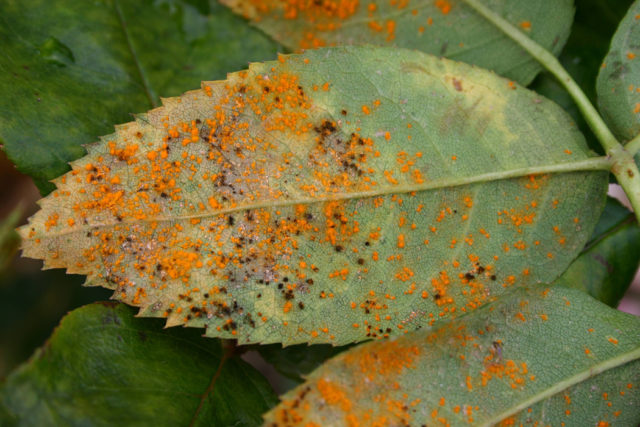
The main symptom of rust is yellow or orange powder spots
Usually the disease appears on the lower part of the leaf plate on roses. It looks like small yellow specks, the number of which is gradually increasing. These are small fungi, they quickly multiply by spores.
In the future, the infection penetrates into the tissue of the leaf. After a few weeks, the plates begin to turn yellow, completely covered with rusty spots, wither and dry.
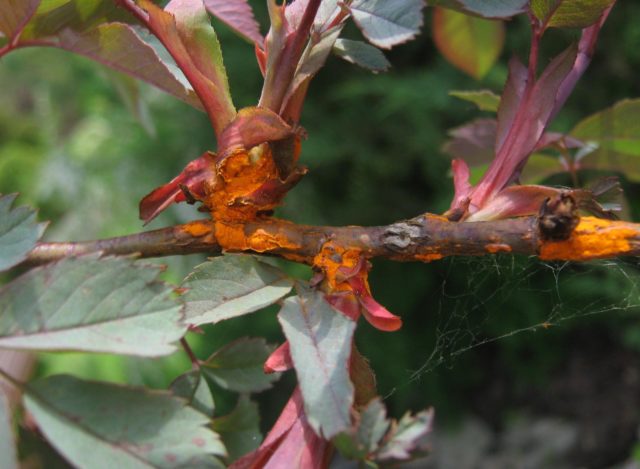
In the later stages, the disease also affects the shoots of the rose.
During the flowering period, rust can spread to the buds. The fungus interferes with the normal course of photosynthesis in rose cells. At the same time, the infection absorbs the nutrients that the plant has accumulated. As a result, the bush begins to discolor from a lack of chlorophyll. If untreated, the plant becomes very weak and subsequently dries up or freezes in winter.
Reasons for the appearance
Rust is caused by fungi from the genus Gymnosporangium. Most often, the infection affects conifers, especially shrub junipers. The appearance of rose rust disease is usually associated with the fact that the plant is weakened by adverse factors affecting it.
The appearance of spots on the leaves can be caused by:
- violation of the irrigation regime;
- high air humidity at low temperatures;
- violation of landing technology;
- excess nitrogen in the soil;
- poor aeration of the plant;
- the presence of wilted buds on the bushes.
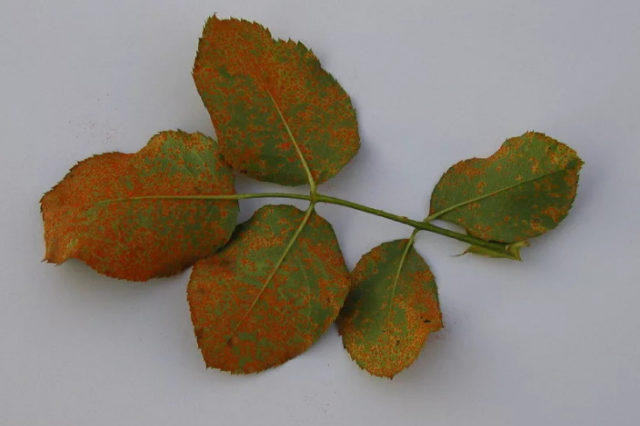
Improper use of organic fertilizers can lead to illness
Often, roses are infected with rust from other plants on the site. This suggests the need to periodically check all shrubs for symptoms of the disease.
What is the danger of the disease
Rusty spots on the leaves are considered one of the most dangerous infections. Most rose varieties are susceptible to fungi. Infection leads to a number of negative consequences.
Among them:
- loss of decorativeness;
- lack of flowering;
- premature wilting;
- spreading fungi from a rose to the leaves of other plants in the garden;
- the potential for the death of the bush.
Rust is the most dangerous for young plants. They show less resistance to disease.
What to do and how to treat rose leaves from rust
First of all, the plant must be carefully examined to determine the degree of infection. If there is a small amount of small rusty spots on the leaves, it is enough to process it. In the later stages, affected shoots are removed to prevent the spread of infection to healthy stems.
Fungicides
If the leaves of the rose are covered with rusty spots, it is recommended to use potent antifungal drugs. Fungicides disrupt cell metabolism, create conditions for the death of pathogenic microorganisms. Below are the most effective anti-rust preparations on rose leaves.
Fitosporin-M
Antifungal agent with a broad spectrum of action. It is a bacterial fungicide. The active ingredient is microorganisms that suppress the fungus, and at the same time do not harm the diseased plant.
For spraying rose leaves, use "Fitosporin-M" in powder form. For 10 liters of water take 15 g of the drug. A sick bush is sprayed with an interval of 7 days until the spots on the leaves disappear.
Topaz
Systemic biological fungicide, used for flowering and fruit plants. It is characterized by high efficiency in disease, fast action. The product inhibits the growth of rust on the leaves, protects healthy shoots and rose flowers from infection.
The drug is produced in ampoules of 2 ml. It is diluted in 5 liters of water and sprayed with a diseased bush.

Spraying roses is advised to be carried out in calm dry weather.
Re-processing of leaves from rust is carried out after 10 days. The fungicide does not possess phototoxic properties, therefore it is safe for the plant.
Strobe
The drug is in the form of soluble capsules for the preparation of a liquid solution. The product is highly effective in the first 3-4 hours after spraying.
Sick plants are treated 3 times with an interval of 10 days. 1 g of the drug is dissolved in 10 l of water.
The solution must be prepared just before the procedure. To increase efficiency, you can combine "Strobi" with other fungicides.
Baktofit
It is a bacterial fungicide in powder form. The treatment of roses from rust is carried out by spraying. For 10 liters of water, 20 g of powder is required. The procedure is repeated after 7 days.
Ways to treat roses from stains:
"Baktofit" can also be added to water for irrigation. It is advisable to carry out the procedure to protect the roots and prevent the ingress of fungi from the soil. For 10 liters of water for irrigation, take 30 g of powder.
Folk remedies
Experienced gardeners recommend treating rusty spots on rose leaves not only with fungicides. Antifungal drugs can be supplemented with folk remedies that are no less effective in combating the disease.
Wormwood decoction
Such a remedy is actively used against rust and powdery mildew. The components contained in wormwood suppress fungi.
Cooking method:
- Grind 400 g of dry leaves and wormwood shoots.
- Place in a metal bucket.
- To fill with water.
- Boil.
- Cook for 5-7 minutes.
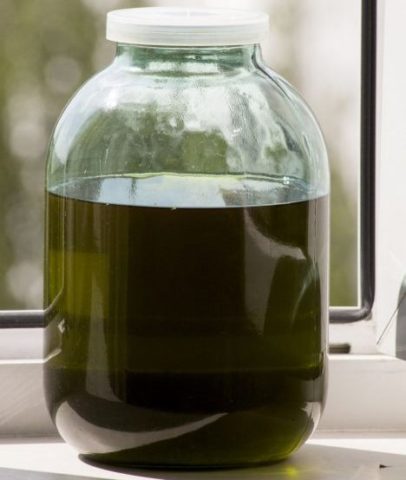
Wormwood broth can be stored in a jar for 2-3 days.
When the liquid is infused and cooled, it must be diluted with water in a ratio of 1 to 1. The broth is used to spray the leaves and soil around a rust-diseased bush.
Soapy water
The tool has a pronounced antibacterial and antifungal effect. The disadvantage of this method is that in order to achieve the result, it is required to spray rose leaves from stains for a long period of time - 30-45 days.
Preparation of rust remover:
- Heat a bucket of water (10 L) on the stove.
- Grind 2 pieces of soap 200 g each on a coarse grater.
- Pour the resulting shavings into hot water.
- Stir the liquid so that it dissolves slightly.
Dilute soapy water before spraying. The procedure is carried out every 2-3 days.
Nettle infusion
An effective remedy for rust stains and other rose diseases. The main disadvantage is the long cooking time.
Preparation of infusion:
- Collect 2 kg of fresh nettles.
- Cut the shoots and leaves.
- Pour 7 liters of boiling water.
- Insist for 10-15 days, stir occasionally.
The liquid will be ready to use after it stops bubbling. The infusion is diluted in water 1 to 2 and sprayed on the bush.
Calendula decoction
The plant has disinfecting and antifungal properties. It is advisable to use it to treat roses from rusty spots on the leaves.
Cooking method:
- Boil 1 liter of water.
- Place 100 g of dry calendula flowers in a container with liquid.
- Cook for 5-7 minutes.
- Cool and drain the liquid.
It turns out a concentrated broth, which must be diluted with water in equal proportions. For the treatment of rust on the leaves of a rose, spraying is carried out 1 time in 7 days.
Prevention of the onset of the disease
The main way to prevent rust is timely and proper maintenance. Rose bushes need periodic watering, loosening and mulching the soil. It is required to properly feed the bushes with fertilizers, to do pruning on time. Leaves should be inspected regularly for small orange spots indicating rust.
Planting disease resistant varieties
In order not to have to treat the rose from spots on the leaves, you can plant plants that are resistant to fungal infections. There are many hybrid varieties that have excellent decorative qualities and are not susceptible to rust.
These include:
- Nostalgie.
- Princess Alexandra.
- Aspirine Rose.
- William Shakespeare.
- Abraham Darby.
- New Dawn.
- Black Magic.
- Westerland.
- Chippendale.
- Angela.
These types of roses are the most resistant to fungi. With proper care, the likelihood of rusty spots on the leaves is excluded.
Timely processing of plants
Flowers and shrubs located in the area next to roses must be subjected to preventive spraying. To do this, use a fungicidal agent or one of the proposed alternative methods.
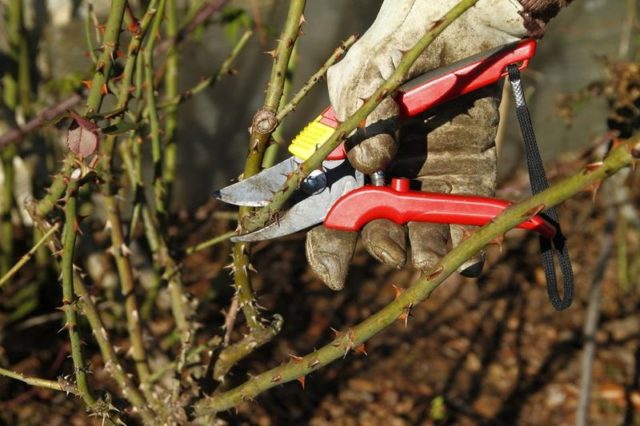
Spraying is carried out in the spring, after a sanitary haircut
During the budding period, the bushes are not processed. During flowering, roses can be sprayed only if spots on the leaves or other signs of disease are detected.
Repeated preventive treatment should be carried out in the fall. For these purposes, Bordeaux liquid or copper sulfate is best suited. Spraying is applied to the bush and the soil around it.
Prophylactic recipe:
Conclusion
Rust on rose leaves is a fungal disease that appears due to improper care and violation of growing conditions. To save a flower, it is extremely important to timely identify spots that indicate damage. Subsequent treatment involves spraying the bushes with fungicides and the use of folk remedies. Competent and timely prevention can significantly reduce the risk of developing the disease.








